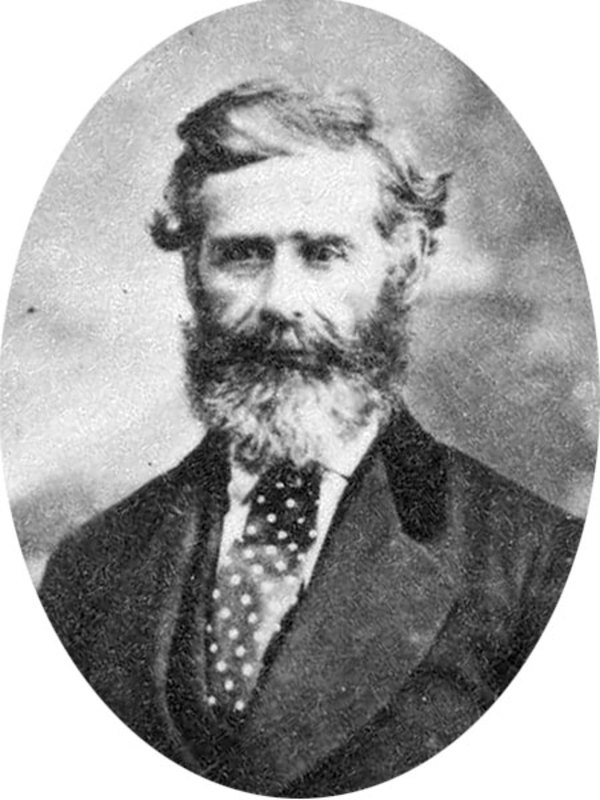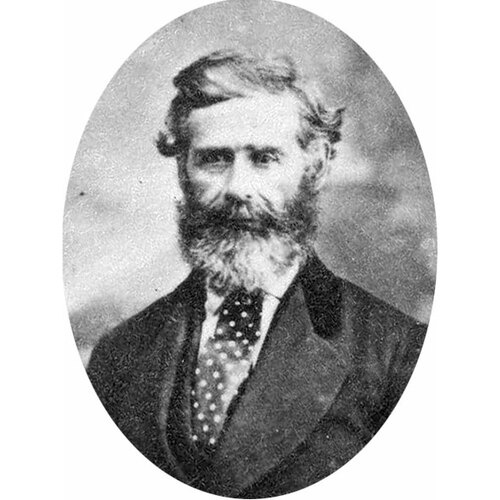As part of the funding agreement between the Dictionary of Canadian Biography and the Canadian Museum of History, we invite readers to take part in a short survey.

Source: Link
FONSECA, WILLIAM GOMEZ (known until around 1840 as Don Derigo Nojada Gomez da Silva Fonseca; in later years he occasionally used da Fonseca), businessman and politician; b. 26 Aug. 1823 in St Croix, Danish West Indies; m. 20 Nov. 1861 Margaret Ann Logan, and they had five sons and five daughters; d. 22 April 1905 in Winnipeg.
At age 17 Don Derigo Nojada Gomez da Silva Fonseca shortened his name to William Gomez Fonseca and left the Danish West Indies for New York, where he received business training in a mercantile firm. A few years later he began to study for the ministry at Nashotah House, an Episcopal college in Nashotah, Wis., but he was forced to abandon that calling after three years because of weak eyes. He then spent two years teaching. In 1850 he journeyed to St Paul (Minn.), at the time considered the future commercial entrepôt for the entire American and British northwest. There, he started a wholesale dry-goods company, and within a few years was conducting a thriving business with retailers in the small towns that were beginning to dot the plains.
Seeking new business opportunities, Fonseca left St Paul with several ox-carts of trade goods and arrived at the Red River settlement (Man.) in the spring of 1860. He established a dry-goods store there in a building belonging to William Inkster, and in a short time disposed of all his wares. The building was located two miles to the north of the main settlement. After investigating matters further Fonseca decided to move his business nearer to the commercial heart of the settlement eventually known as Winnipeg. Later that year he opened a shop in a building owned by Thomas Logan, his future father-in-law, thus beginning a lifelong relationship with that pioneer family. Sometime in the early 1860s he purchased at the north end of Winnipeg a parcel of land which would become a valuable holding. All the while, he enhanced his reputation with local citizens by lecturing on the West Indies, importing tropical fruit, and acting as executor for the estates of deceased members of pioneer families. He was held in such high esteem that just before the colony’s union with Canada the Nor’Wester proposed him for the post of American consul. Although Fonseca was still an American citizen, he was not chosen for the position, which went to Oscar Malmros. During the resistance to the transfer of the colony, Fonseca was taken prisoner by the provisional government of Louis Riel* in December 1869. He was released two days later, after the surrender of his American citizenship papers.
By 1870 Fonseca’s business enterprises were manifold; they included the construction of rental buildings on various portions of his property in northern Winnipeg. One of these structures, known as Fonseca’s Hall or Wolseley House hotel, later became the quarters of Manitoba College. Fonseca operated the hotel and continued in the dry-goods business, also selling hardware, wines, liquors, cigars, groceries, and real estate. He engaged in a number of public-spirited actions; in 1871 school was held in his log house, two years later he was involved in the sinking of a public well, in 1875 he was a member of the board of management of the Winnipeg General Hospital, and that same year he and others purchased and donated a site for the city market. Fonseca hoped that the central business district would extend northward from the city hall-market area, and thereby boost the value of his land. The market site served, however, to establish the northern boundary of the business district. Not until the coming of the railway in the early 1880s did land values rise significantly. Even then, the area where Fonseca owned land became a secondary business district surrounded by cheap residential housing.
In 1873 he was elected to the Winnipeg City Council, and he served six terms as an alderman for the North Ward. Late in 1880 he was persuaded by friends to run for mayor but was defeated by Elias George Conklin. Fonseca continued to pursue his business and real-estate interests during the land boom which occurred with the advent of the Canadian Pacific Railway. The collapse of the boom in 1882 led many critics to doubt the potential of Winnipeg as a commercial centre. Fonseca’s publication of a large, handsome, bird’s-eye-view map of the city in 1884 demonstrated that he still had faith in his adopted home and the map is significant for two reasons. First, the viewer is positioned above the tip of Point Douglas, looking westward, for it was on this bend in the river that Fonseca had his main landholdings. Secondly, the map remains probably the most accurate portrayal of the growth of Winnipeg imaginable in that type of usually over-optimistic publication.
Throughout the 1880s and 1890s, Fonseca continued to be the spokesman for the interests of Winnipeg in general, and of North Winnipeg in particular. At the same time he established a reputation as an expert in horticulture, demonstrating that the soil and climate of the Winnipeg area could support various types of fruit. He was the first to warn Winnipeggers of the canker worm and spruce saw-fly, insects which have periodically devastated the trees of the Red River valley. He also freely gave out his remedy for those insects. As well, he began to enjoy a reputation as a local historian. At one point he began to write his memoirs, but was thwarted by a maid who mistook his papers for rubbish and burnt them.
Despite his advancing years Fonseca remained active in business pursuits. One of these was W. G. Fonseca Limited, which sold mica roofing for buildings. Fonseca staged a demonstration of the product at the Winnipeg Industrial Exhibition of July 1894. During his retirement he directed his children who operated his various enterprises. In 1903 he sustained head injuries when he slipped on ice. His health deteriorated until his death two years later. He was buried in the cemetery of St John’s Cathedral, where he had been vestryman for over three decades. Throughout his life, William Gomez Fonseca had subscribed to the simple rules: “Study to mend your own business” and “Bridle that unruly member, the tongue.” After his death, Manitoba historian Frank Howard Schofield wrote that “he left the impress of his individuality upon the city and its history.” Of all the pioneer citizens of Winnipeg, he was the one who best epitomized the term “grand old man.”
William Gomez Fonseca is the author of On the St. Paul trail in the sixties (Winnipeg, 1900).
PAM, P3756, file 4. Daily Nor’Wester (Winnipeg), 24 Feb., 5, 24 May 1894. Nor’Wester, 15 Nov. 1860; 15 April, 14 Sept. 1861; 7 Nov. 1868; 1 May 1869. Nor’Wester (Winnipeg), 16 Aug. 1875. Weekly Manitoban and Herald of Rupert’s Land and North-Western Territory (Winnipeg), 22 July 1871, 29 June 1872. Winnipeg Free Press, 13 June 1894; 24, 26 April 1905; 6 June 1949. Winnipeg Tribune, 13 June 1893; 19 June, 25 July, 11 Aug. 1894. Bryce, Hist. of Man. A. G. Fonseca, From palms to maples: the story of William Gomez Fonseca, one of Winnipeg’s earliest pioneers (Winnipeg, 1988). In the Supreme Court of Canada . . . between William Gomez Fonseca & John Christian Schultz . . . and her majesty’s attorney-general for Canada . . . appellants’ faetum . . . (Winnipeg, 1888). In the Supreme Court of Canada, between William Gomez Fonseca and John Christian Schultz . . . and her majesty’s attorney-general for Canada . . . respondent’s factum . . . (Winnipeg, 1888). In the Supreme Court of Canada . . . between William Gomez Fonseca and John Christian Schultz . . . and her majesty’s attorney-general for Canada . . . the case . . . (Winnipeg, 1888). F. H. Schofield, The story of Manitoba (3v., Winnipeg, 1913).
Cite This Article
Randy R. Rostecki, “FONSECA, WILLIAM GOMEZ (Don Derigo Nojada Gomez da Silva Fonseca, da Fonseca),” in Dictionary of Canadian Biography, vol. 13, University of Toronto/Université Laval, 2003–, accessed March 29, 2025, https://www.biographi.ca/en/bio/fonseca_william_gomez_13E.html.
The citation above shows the format for footnotes and endnotes according to the Chicago manual of style (16th edition). Information to be used in other citation formats:
| Permalink: | https://www.biographi.ca/en/bio/fonseca_william_gomez_13E.html |
| Author of Article: | Randy R. Rostecki |
| Title of Article: | FONSECA, WILLIAM GOMEZ (Don Derigo Nojada Gomez da Silva Fonseca, da Fonseca) |
| Publication Name: | Dictionary of Canadian Biography, vol. 13 |
| Publisher: | University of Toronto/Université Laval |
| Year of revision: | 1994 |
| Access Date: | March 29, 2025 |



